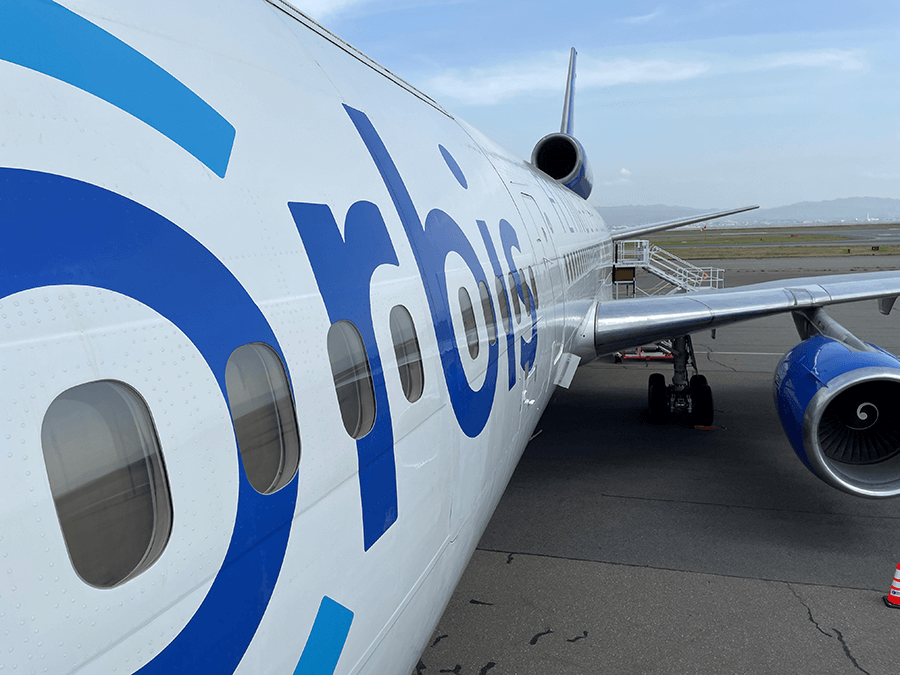Where Do Old Planes Go When They Retire?
A one-of-a-kind aircraft is jetting the world as a flying hospital, bringing access to quality eye care to underserved communities around the globe.
Have you ever wondered what happens to planes that are no longer in the skies?
According to the International Air Transport Association (IATA), around 16,000 commercial passenger and cargo aircraft have been retired worldwide in the last 35 years with 11,000 more retirements expected over the next decade. But what happens to these planes once they are taken out of service?
In most cases, a retired plane will take on another life in one of two ways: It will either be sold to a new owner, or head to the scrapyard. IATA estimates that, if decommissioned at the right time and in the appropriate manner, 90 percent of an aircraft’s parts can be reused or recycled.
RELATED: How Boeing built FedEx’s ecoDemonstrator plane
On average, commercial aircraft are replaced every 22 years , but with careful maintenance work, they can continue to fly for 30 years or more. Today, FedEx operates around 700 aircraft, including Boeing 777F and 767Fs. And now, one special plane that was once a mainstay of the FedEx fleet has gone on to transform lives around the world.
According to the International Air Transport Association (IATA), around 16,000 commercial passenger and cargo aircraft have been retired worldwide in the last 35 years with 11,000 more retirements expected over the next decade. But what happens to these planes once they are taken out of service?
In most cases, a retired plane will take on another life in one of two ways: It will either be sold to a new owner, or head to the scrapyard. IATA estimates that, if decommissioned at the right time and in the appropriate manner, 90 percent of an aircraft’s parts can be reused or recycled.
RELATED: How Boeing built FedEx’s ecoDemonstrator plane
From cargo plane to a Flying Hospital
On average, commercial aircraft are replaced every 22 years , but with careful maintenance work, they can continue to fly for 30 years or more. Today, FedEx operates around 700 aircraft, including Boeing 777F and 767Fs. And now, one special plane that was once a mainstay of the FedEx fleet has gone on to transform lives around the world.

A FedEx MD-10 has embarked on a truly unique course after being transformed into a mobile teaching hospital fitted with a state-of-the-art operating room, recovery room, and classroom. The Flying Eye Hospital, operated by Orbis International, is a fully accredited ophthalmic teaching hospital that travels the world providing vision-saving eye surgeries and training to local eye care teams.
To date, the Flying Eye Hospital program has delivered world-class training to eyecare teams in 95 countries. A recent mission to the Can Tho region of Vietnam, sponsored by FedEx, provided hands-on training to 52 eye care professionals, including ophthalmologists, nurses, and biomedical engineers. Through such missions, Orbis staff, volunteers, and partner companies such as FedEx are working to bring an end to preventable blindness by improving access to quality eye care.
At FedEx, we connect people and possibilities, working to make our world a better place. The Flying Eye Hospital program is a unique opportunity to use our resources and operational strengths as the world’s largest cargo airline to help address the needs of underserved communities.
It takes a special skillset to operate and maintain an older aircraft, but luckily, we have ample experience in this area. At one time, with more than 184 MD-10s, the model was the backbone of the FedEx fleet for many years. While we gradually transitioned our fleet to newer, more efficient aircraft, it was only in December 2022 that the last MD-10s were grounded.
RELATED: How FedEx gives new life to old uniforms
For more than 30 years, we’ve supported the Orbis program through financial donations and in-kind shipping. We also help to maintain and operate this unique aircraft.
According to a retired FedEx pilot who has volunteered for the program for 10 years, the Flying Eye Hospital is “an older airplane and we need to treat it like a piece of gold treasure that it is, so we’re very careful with it.”
As one of the few airlines capable of operating the MD-10 safely today, we provide aircraft parts, maintenance, and pilot training to Orbis. Our pilots also volunteer their time to navigate the plane around the world on various missions and projects. FedEx staff around the world also play an important role in supporting Orbis missions, assisting with ground handling when the Flying Eye Hospital arrives its destination.
To date, the Flying Eye Hospital program has delivered world-class training to eyecare teams in 95 countries. A recent mission to the Can Tho region of Vietnam, sponsored by FedEx, provided hands-on training to 52 eye care professionals, including ophthalmologists, nurses, and biomedical engineers. Through such missions, Orbis staff, volunteers, and partner companies such as FedEx are working to bring an end to preventable blindness by improving access to quality eye care.
Making a positive difference by doing what we do best
At FedEx, we connect people and possibilities, working to make our world a better place. The Flying Eye Hospital program is a unique opportunity to use our resources and operational strengths as the world’s largest cargo airline to help address the needs of underserved communities.
It takes a special skillset to operate and maintain an older aircraft, but luckily, we have ample experience in this area. At one time, with more than 184 MD-10s, the model was the backbone of the FedEx fleet for many years. While we gradually transitioned our fleet to newer, more efficient aircraft, it was only in December 2022 that the last MD-10s were grounded.
RELATED: How FedEx gives new life to old uniforms
For more than 30 years, we’ve supported the Orbis program through financial donations and in-kind shipping. We also help to maintain and operate this unique aircraft.
According to a retired FedEx pilot who has volunteered for the program for 10 years, the Flying Eye Hospital is “an older airplane and we need to treat it like a piece of gold treasure that it is, so we’re very careful with it.”
As one of the few airlines capable of operating the MD-10 safely today, we provide aircraft parts, maintenance, and pilot training to Orbis. Our pilots also volunteer their time to navigate the plane around the world on various missions and projects. FedEx staff around the world also play an important role in supporting Orbis missions, assisting with ground handling when the Flying Eye Hospital arrives its destination.

In 2021, we renewed our commitment to Orbis’s mission and pledged to provide financial, logistical, and operation support to the organization and the Flying Eye Hospital over the following five years.
We are proud to report that we exceeded this ambitious goal and remain committed as ever to using our resources and network to deliver hope to the communities in which we operate.
What drives this passion? It’s our focus on people. Describing one of their proudest moments as a volunteer, a retired FedEx pilot recounted the moment a child got to see their parent for the first time. “As soon as they see their parent for the first time, it’s more than a smile of happiness – it’s that familiarity and love that touches me every time.”
To learn the more about how FedEx is making an impact around the world, check out our FedEx Cares page and our latest CSR initiatives here.
We are proud to report that we exceeded this ambitious goal and remain committed as ever to using our resources and network to deliver hope to the communities in which we operate.
What drives this passion? It’s our focus on people. Describing one of their proudest moments as a volunteer, a retired FedEx pilot recounted the moment a child got to see their parent for the first time. “As soon as they see their parent for the first time, it’s more than a smile of happiness – it’s that familiarity and love that touches me every time.”
To learn the more about how FedEx is making an impact around the world, check out our FedEx Cares page and our latest CSR initiatives here.
***
















 The Latest
The Latest